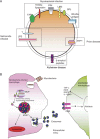Exosome function: from tumor immunology to pathogen biology
- PMID: 18331451
- PMCID: PMC3636814
- DOI: 10.1111/j.1600-0854.2008.00734.x
Exosome function: from tumor immunology to pathogen biology
Abstract
Exosomes are the newest family member of 'bioactive vesicles' that function to promote intercellular communication. Exosomes are derived from the fusion of multivesicular bodies with the plasma membrane and extracellular release of the intraluminal vesicles. Recent studies have focused on the biogenesis and composition of exosomes as well as regulation of exosome release. Exosomes have been shown to be released by cells of hematopoietic and non-hematopoietic origin, yet their function remains enigmatic. Much of the prior work has focused on exosomes as a source of tumor antigens and in presentation of tumor antigens to T cells. However, new studies have shown that exosomes might also promote cell-to-cell spread of infectious agents. Moreover, exosomes isolated from cells infected with various intracellular pathogens, including Mycobacterium tuberculosis and Toxoplasma gondii, have been shown to contain microbial components and can promote antigen presentation and macrophage activation, suggesting that exosomes may function in immune surveillance. In this review, we summarize our understanding of exosome biogenesis but focus primarily on new insights into exosome function. We also discuss their possible use as disease biomarkers and vaccine candidates.
Figures




References
-
- Johnstone RM, Adam M, Hammond JR, Orr L, Turbide C. Vesicle formation during reticulocyte maturation. Association of plasma membrane activities with released vesicles (exosomes). J Biol Chem 1987;262:9412–9420. - PubMed
-
- Couzin J. Cell biology: the ins and outs of exosomes. Science 2005;308:1862–1863. - PubMed
Publication types
MeSH terms
Grants and funding
LinkOut - more resources
Full Text Sources
Other Literature Sources

